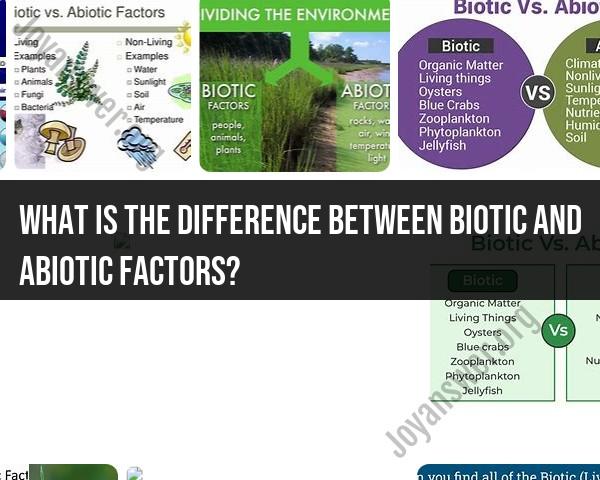What is the difference between biotic and abiotic factors?
Biotic and abiotic factors are two fundamental components used to describe and understand ecosystems. Here are the key differences between biotic and abiotic factors:
Biotic Factors:
Definition:
- Biotic factors are living or once-living components of an ecosystem. These include all organisms, from the smallest microorganisms to the largest mammals.
Examples:
- Plants, animals, fungi, bacteria, protists, and humans are examples of biotic factors.
Interactions:
- Biotic factors interact with each other in various ways, such as predation, competition, mutualism, parasitism, and symbiosis.
Source of Energy:
- Biotic factors often rely on other living organisms for energy. For example, plants use sunlight through photosynthesis, herbivores consume plants, and carnivores consume other animals.
Role in Ecosystems:
- Biotic factors play crucial roles in nutrient cycling, energy transfer, and maintaining the balance of ecosystems.
Abiotic Factors:
Definition:
- Abiotic factors are non-living components of an ecosystem. These include physical and chemical elements that influence the environment.
Examples:
- Examples of abiotic factors include sunlight, temperature, water, soil, air, rocks, minerals, and atmospheric gases.
Interactions:
- Abiotic factors influence the distribution and behavior of biotic factors. For example, temperature affects the metabolic processes of organisms, and the availability of water influences the types of plants and animals that can thrive in an area.
Source of Energy:
- Abiotic factors, particularly sunlight, serve as the primary source of energy for ecosystems. Sunlight is essential for photosynthesis in plants, which forms the basis of many food chains.
Role in Ecosystems:
- Abiotic factors influence the physical structure of ecosystems and contribute to the overall environmental conditions. They play a role in shaping biodiversity, determining the types of organisms that can survive in a particular habitat.
Interconnectedness:
Biotic and abiotic factors are interconnected, and changes in one component can have cascading effects throughout an ecosystem. For example, changes in temperature (abiotic) can influence the behavior and distribution of certain species (biotic).
Ecosystems are dynamic and complex systems where the interactions between biotic and abiotic factors contribute to the overall stability and functioning of the environment.
Understanding the distinction between biotic and abiotic factors is essential for ecologists, environmental scientists, and anyone studying or managing ecosystems, as it provides insights into the delicate balance that sustains life in different environments.
What distinguishes biotic factors from abiotic factors within an ecosystem?
The two main components of an ecosystem are biotic and abiotic factors. Here's what distinguishes them:
Biotic factors:
- Living: Biotic factors are all living things within an ecosystem. This includes plants, animals, bacteria, fungi, and other organisms.
- Interactive: Biotic factors interact with each other in various ways, such as through predator-prey relationships, symbiotic relationships, and competition for resources.
- Dynamic: Biotic factors are constantly changing and evolving over time. This can be due to factors such as birth, death, growth, reproduction, and migration.
Examples of biotic factors:
- Plants: Trees, shrubs, grasses, flowers, algae
- Animals: Insects, birds, mammals, fish, reptiles, amphibians
- Bacteria: Found in soil, water, and on living organisms
- Fungi: Mushrooms, molds, yeasts
Abiotic factors:
- Non-living: Abiotic factors are the non-living components of an ecosystem. This includes things like water, air, soil, sunlight, temperature, humidity, pH, and salinity.
- Influential: Abiotic factors influence the survival and distribution of biotic factors. For example, plants need sunlight and water to grow, and animals need food and water to survive.
- Stable: Abiotic factors are relatively stable compared to biotic factors. However, they can also change over time due to factors such as climate change, pollution, and natural disasters.
Examples of abiotic factors:
- Water: Oceans, rivers, lakes, streams, groundwater
- Air: Oxygen, carbon dioxide, nitrogen, other gases
- Soil: Minerals, nutrients, sand, clay, organic matter
- Sunlight: Provides energy for plants to grow through photosynthesis
- Temperature: Affects the distribution and activity of organisms
- Humidity: The amount of moisture in the air
- pH: The acidity or alkalinity of the soil or water
- Salinity: The amount of salt in the water
The relationship between biotic and abiotic factors:
Biotic and abiotic factors are interconnected and interdependent. They interact with each other in complex ways to create and maintain a balanced ecosystem. For example, plants take in carbon dioxide from the air and release oxygen, which is essential for animals to breathe. Animals eat plants and other organisms, which helps to recycle nutrients in the ecosystem. Changes in abiotic factors, such as climate change or pollution, can have a significant impact on the distribution and survival of biotic factors.
Understanding the distinction and interaction between biotic and abiotic factors is crucial for studying and managing ecosystems effectively. It helps us to understand how ecosystems function and how human activities can impact them.


